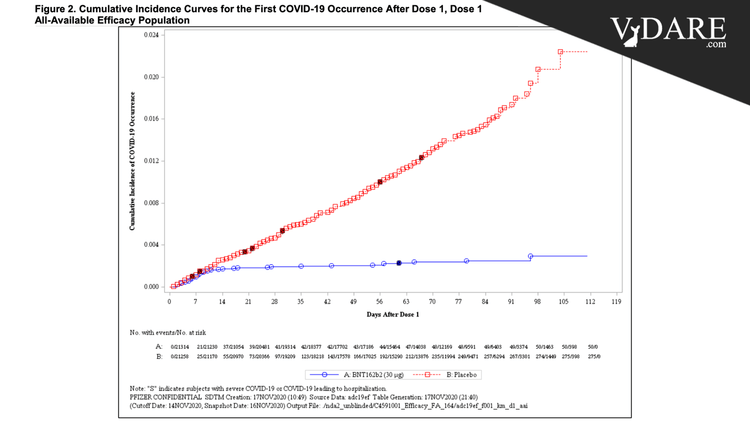
Vaccine Stats
12/09/2020
From Pfizer’s vaccine application to the FDA, here are the cumulative COVID case counts (vertical axis) for the vaccine arm (blue dots) and the placebo arm (red dots). The horizontal axis measures time in days from the first shot.

That’s a rather encouraging graph, no?
This suggests that the vaccine’s effect kicks in about two weeks after the first inoculation and is almost as strong as after two inoculations (the second shot is scheduled for 21 days after the first shot, with the clinical trial beginning counting cases 7 days after the second shot, or 28 days after the first shot). But, it looks like we get close to full effect in 14 days rather than 28 days, which is good news during the current Third Wave, that, while it’s finally fading in the Upper Midwest, is still worsening in both the West and the East.
If you start counting cases after two weeks rather than after four weeks, you get 13 cases in the vaccine arm and 220 in the placebo arm for 94.4% efficacy. The official case count, beginning after four weeks, gives you 8 cases in the vaccine arm and 162 in the placebo arm, for 95.3% efficacy.
I’m assuming they test volunteers when they come in for their first shot to see if already have COVID, so those 37 out of 21,054 in the vaccine arm who got a case of COVID in the first few weeks were infected after their initial shot. If that wasn’t true and instead they were previously infected and only becoming symptomatic after their first inoculation, then that would suggest the vaccine works almost instantly. (But I don’t think that’s true, so don’t assume it.)
That raises the question of whether the second shot is really necessary, although it could be that the efficacy would wear off faster without the second shot. They may have a small amount of data on people who didn’t get around to getting their second shot until, say, 28 or 35 days after their first shot. Somebody should look into those folks and how they did. Theoretically, you could make the vaccine go further during the crucial upcoming weeks by extending the lag between the first and second shot from three weeks to, say, five weeks.
